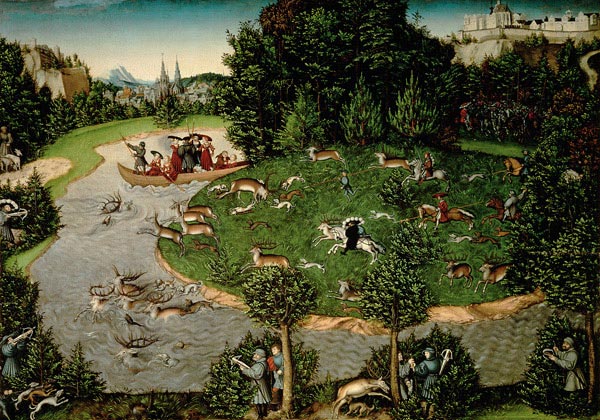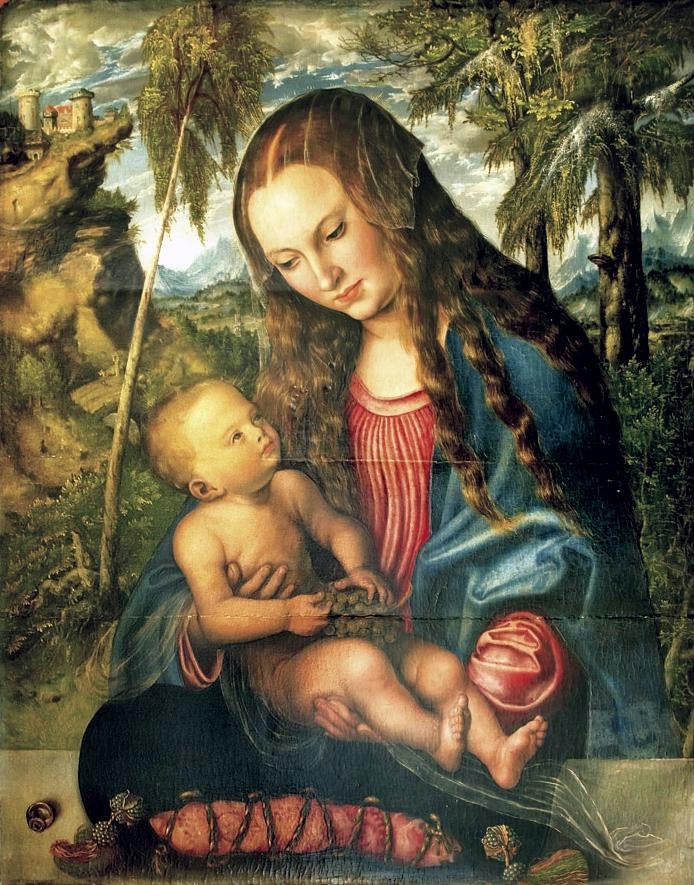| Lucas Cranach the Elder | |
|---|---|
 |
|
| Born | Lucas Maler Oct. 4, 1472 Kronach |
| Died | Oct. 16, 1553 (at age 81) Weimar |
| Nationality | German |
| Movement | German Renaissance |
| Field | Painting |
| Works | |
An Artist With Many Talents
The German Renaissance artist Lucas Cranach the Elder, was known for his period paintings, being a printmaker, using woodcut and engraving. He also painted altar pieces for the Castle Church at Wittenberg, was the Electors of Saxony court painter, designed coins for the electorate, owned a workshop with two of his sons, and also owned an apothecary shop. He befriended Martin Luther, the prominent figure of Protestant Reformation, and embraced his teachings, later painting to convey Lutheran principles through his art.
Lucas Cranach the Elder’s Sketchy History
Lucas, the eldest of nine children, was born in Kronach, which is in the upper part of Franconia, Germany. Because there are not many records of his study in art, it is assumed that he learned the art of drawing and later painting, from his father Hans, who was also a painter. Lucas took the name Cranach in mid-life, which refers to the place in which he was born. Near the year 1500, Lucas moved to Vienna, where some of his most original works were painted. His portrait, Johannes Cuspinian and his wife Anna, were painted at or around this time.
In 1504, Cranach was appointed to the court of Frederic III, where he began working in Wittenberg as the court painter. He remained in this position for the rest of his career. When he accepted the position of pictor ducalis, or the duke’s painter, he was not allowed to undertake any further works on his own. Soon after moving to Wittenberg, Cranach met, and became friends with the reformer Martin Luther. Martin Luther, a German priest, and professor of theology, was the prominent figure of the Protestant Reformation, challenging the authority of the Pope and Catholic Church of the time.
 In 1522, Lucas printed Martin Luther’s German translation of the New Testament, and helped to convey Lutheran principles through his art. In 1524, Lucas met Albrecht Durer, an important German Renaissance artist. Cranach married, and he and his wife Barbara had five children. Two of Cranach’s sons, Lucas the Younger, and Hans, became artists themselves, helping him to run a workshop which produced many thousands of paintings, prints, and engravings. Cranach sold medicines and paper, printed and sold books, and ran a wine pub. He was an elected member of the Wittenberg city council, and was also elected Mayor three times.
In 1522, Lucas printed Martin Luther’s German translation of the New Testament, and helped to convey Lutheran principles through his art. In 1524, Lucas met Albrecht Durer, an important German Renaissance artist. Cranach married, and he and his wife Barbara had five children. Two of Cranach’s sons, Lucas the Younger, and Hans, became artists themselves, helping him to run a workshop which produced many thousands of paintings, prints, and engravings. Cranach sold medicines and paper, printed and sold books, and ran a wine pub. He was an elected member of the Wittenberg city council, and was also elected Mayor three times.
 Many historians believe that Lucas Cranach the Elder’s talent for juggling politics allowed him to provide art for Catholic, as well as Protestant, requests. Because of his many interests, and businesses, he became the wealthiest civilian in Wittenberg. When his wife died in 1540, Cranach moved to Weimar, following John Frederic I. In 1553, Lucas died and his sons continued his businesses. Today there is an art school where Cranach previously had his businesses in Wittenberg.
Many historians believe that Lucas Cranach the Elder’s talent for juggling politics allowed him to provide art for Catholic, as well as Protestant, requests. Because of his many interests, and businesses, he became the wealthiest civilian in Wittenberg. When his wife died in 1540, Cranach moved to Weimar, following John Frederic I. In 1553, Lucas died and his sons continued his businesses. Today there is an art school where Cranach previously had his businesses in Wittenberg.
Observations of Cranach’s Art
Lucas Cranach the Elder painted religious subjects,portraits, still life, and game. His portraits were sometimes full-length, as in The Duke and Duchess of Saxony. His religious paintings initially reflected the Catholic traditions, yet in later years, portrayed the Lutheran religion of the Protestant Reformation. He painted subjects ranging from German princes to ordinary citizens in everyday settings, who were often shown close to Christ, with saints and noblemen in the backgrounds. Cranach emphasized man’s individuality, and that salvation comes from faith, rather than good work or good deeds.
Cranach worked with oil paints, usually on panels of wood. Art historians have noted that while in Vienna, Cranach’s paintings were very dynamic  and filled with expression. His works became rather static after his move to Wittenberg. His controlled painting style may have been directed by the church influence of his position. Cranach also painted nude subjects from religion and mythology, such as in his painting Reclining Nymph.
and filled with expression. His works became rather static after his move to Wittenberg. His controlled painting style may have been directed by the church influence of his position. Cranach also painted nude subjects from religion and mythology, such as in his painting Reclining Nymph.
Cranach signed his early paintings and works with his initials until 1508, when the elector assigned the winged snake with a ruby ring as his emblem or Kleinod, which was viewed as an order of merit. He used this insignia as his signature thereafter. Lucas Cranach the Elder is honored today, along with Albrecht Durer, with a feast day in the Episcopal Church in the United States, and is commemorated as a saint by the Lutheran Church, along with Durer as well. One of his last works was an altarpiece for the city church at Weimar, which was completed by his son Lucas the Younger, following his death.